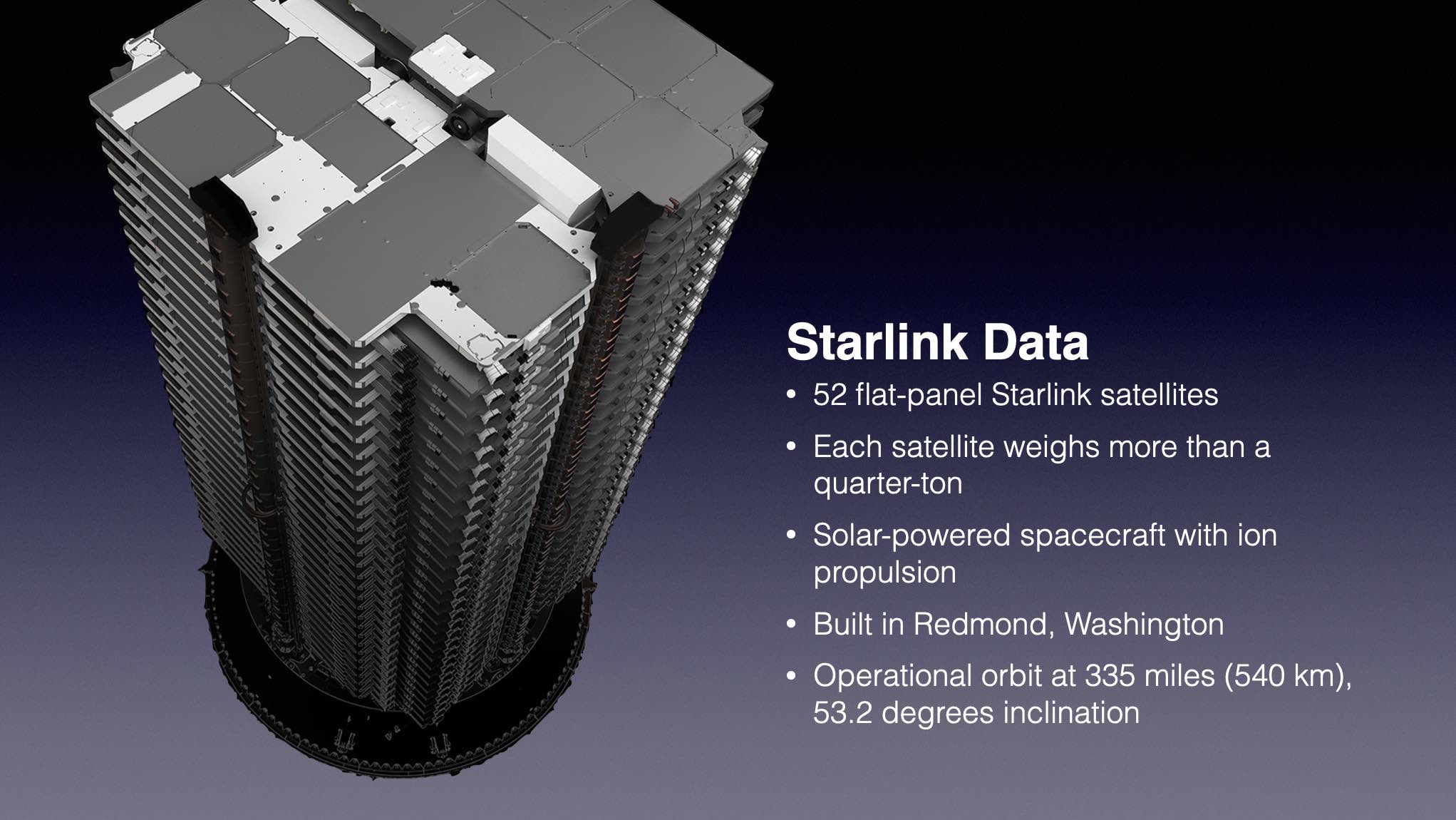Space News & Blog Articles
Live coverage: Fifty-two more Starlink satellites set for launch today
Live coverage of the countdown and launch of a SpaceX Falcon 9 rocket from Launch Complex 39A at NASA’s Kennedy Space Center in Florida. The Starlink 4-26 mission will launch SpaceX’s next batch of 53 Starlink broadband satellites. Follow us on Twitter.
SFN Live
SpaceX is counting down to liftoff of a Falcon 9 rocket and 52 more Starlink internet satellites Tuesday at NASA’s Kennedy Space Center in Florida. The commercial mission is set for launch into low Earth orbit at 6:57 p.m. EDT (2257 GMT), and the Falcon 9’s reusable first stage will target a landing on an offshore drone ship.
There’s a 70% chance of favorable weather for liftoff Tuesday, according to the U.S. Space Force’s 45th Weather Squadron.
The Falcon 9 rocket will head northeast from the Kennedy Space Center, aiming to deliver the flat-packed broadband relay stations to an orbit ranging between 144 miles and 208 miles in altitude (232-by-338 kilometers). Deployment of the 52 flat-packed satellites from the Falcon 9’s upper stage will occur about 15 minutes after liftoff.
With Tuesday’s mission, designated Starlink 4-26, SpaceX will have launched 3,,09 Starlink internet satellites, including prototypes and test units no longer in service. The launch Tuesday will mark the 54th SpaceX mission primarily dedicated to hauling Starlink internet satellites into orbit.
Stationed inside a firing room at a launch control center at Kennedy, SpaceX’s launch team will begin loading super-chilled, densified kerosene and liquid oxygen propellants into the 229-foot-tall (70-meter) Falcon 9 vehicle at T-minus 35 minutes.
Helium pressurant will also flow into the rocket in the last half-hour of the countdown. In the final seven minutes before liftoff, the Falcon 9’s Merlin main engines will be thermally conditioned for flight through a procedure known as “chilldown.” The Falcon 9’s guidance and range safety systems will also be configured for launch.
After liftoff, the Falcon 9 rocket will vector its 1.7 million pounds of thrust — produced by nine Merlin engines — to steer northeast over the Atlantic Ocean.
The rocket will exceed the speed of sound in about one minute, then shut down its nine main engines two-and-a-half minutes after liftoff. The booster stage will release from the Falcon 9’s upper stage, then fire pulses from cold gas control thrusters and extend titanium grid fins to help steer the vehicle back into the atmosphere.
Two braking burns will slow the rocket for landing on the drone ship “A Shortfall of Gravitas” around 400 miles (650 kilometers) downrange approximately eight-and-a-half minutes after liftoff.
 Credit: Spaceflight Now
Credit: Spaceflight Now
The booster flying on the Starlink 4-26 mission, known as B1073, will launch on its third trip to space. It debuted in May with a previous launch for the Starlink program, then flew again June 29 with the commercial SES 22 television broadcasting satellite.
Landing of the first stage on Tuesday’s mission will occur moments after the Falcon 9’s second stage engine cuts off to deliver the Starlink satellites into orbit. Separation of the 52 spacecraft, built by SpaceX in Redmond, Washington, from the Falcon 9 rocket is scheduled for T+plus 15 minutes, 24 seconds.
Retention rods will release from the Starlink payload stack, allowing the flat-packed satellites to fly free from the Falcon 9’s upper stage in orbit. The 52 spacecraft will unfurl solar arrays and run through automated activation steps, then use krypton-fueled ion engines to maneuver into their operational orbit.
The Falcon 9’s guidance computer aims deploy the satellites into an elliptical orbit at an orbital inclination of 53.2 degrees to the equator. The satellites will use on-board propulsion to do the rest of the work to reach a circular orbit 335 miles (540 kilometers) above Earth.
The Starlink satellites will fly in one of five orbital “shells” at different inclinations for SpaceX’s global internet network. After reaching their operational orbit, the satellites will enter commercial service and begin beaming broadband signals to consumers, who can purchase Starlink service and connect to the network with a SpaceX-supplied ground terminal.
ROCKET: Falcon 9 (B1073.3)
PAYLOAD: 52 Starlink satellites (Starlink 4-26)
LAUNCH SITE: LC-39A, Kennedy Space Center, Florida
LAUNCH DATE: Aug. 9, 2022
LAUNCH TIME: 6:57:40 p.m. EDT (2257:40 GMT)
WEATHER FORECAST: 70% chance of acceptable weather; Low risk of upper level winds; Low risk of unfavorable conditions for booster recovery
BOOSTER RECOVERY: “A Shortfall of Gravitas” drone ship east of Charleston, South Carolina
LAUNCH AZIMUTH: Northeast
TARGET ORBIT: 144 miles by 208 miles (232 kilometers by 335 kilometers), 53.2 degrees inclination
LAUNCH TIMELINE:
T+00:00: Liftoff T+01:12: Maximum aerodynamic pressure (Max-Q) T+02:26: First stage main engine cutoff (MECO) T+02:30: Stage separation T+02:36: Second stage engine ignition T+02:41: Fairing jettison T+06:45: First stage entry burn ignition (three engines) T+07:06: First stage entry burn cutoff T+08:19: First stage landing burn ignition (one engine) T+08:43: Second stage engine cutoff (SECO 1) T+08:44: First stage landing T+15:24: Starlink satellite separationMISSION STATS:
169th launch of a Falcon 9 rocket since 2010 177th launch of Falcon rocket family since 2006 3rd launch of Falcon 9 booster B1073 146th Falcon 9 launch from Florida’s Space Coast 53rd SpaceX launch from pad 39A 147th launch overall from pad 39A 111th flight of a reused Falcon 9 booster 54th dedicated Falcon 9 launch with Starlink satellites 35th Falcon 9 launch of 2022 35th launch by SpaceX in 2022 35th orbital launch attempt based out of Cape Canaveral in 2022This email address is being protected from spambots. You need JavaScript enabled to view it. the author.
Follow Stephen Clark on Twitter: @StephenClark1.
When you subscribe to the SpaceZE News Feed, we will send you an e-mail when there are new updates on the site so you wouldn't miss them.

